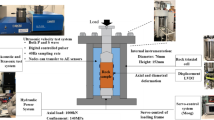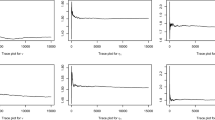Abstract
Fragility curves, commonly derived using analytical methods, are important ingredients of seismic risk analysis of structures in the framework of performance-based earthquake engineering. Hence, the accurate estimation of realistic fragility functions is a decisive *: Bayesian updating considering a diffuse prior step in a reliable risk assessment. This paper proposes a Bayesian updating procedure applied to analytical fragility curves of reinforced concrete (RC) structures based on data from experimental tests, namely shaking table tests. The latter are commonly performed by progressively increasing the intensity of the input motion applied to the same test specimen. In this regard, the maximal benefit from the output of a shaking table test is sought here, aiming to convert n sequential stages of a shaking table test of a single virgin specimen into n equivalent shaking table tests that are performed on n virgin specimens. This is performed by modifying the intensity of the input motion applied during the stage-wise testing based on a damage index coefficient. The parametric studies performed to validate this objective reveal that the approach is more suitable for simple structures compared to large or complex structures. The ATC-58 and Markov Chain Monte Carlo (MCMC) approaches for Bayesian updating of fragility curves are also closely examined and compared. The proposed Bayesian updating is applied to a RC structure, where fragility curves that are derived from incremental dynamic analysis are updated using shaking table results. The updating is examined considering three damage state models, namely HAZUS, homogenized RC and strain-based damages states. This work also highlights the pitfalls of using a limited sample of experimental test data for updating less reliable priors. Besides, the MCMC-based approach is shown to be more robust in the presence of complex analytical fragilities than the ATC-58 approach.
























Similar content being viewed by others
Change history
20 January 2023
A Correction to this paper has been published: https://doi.org/10.1007/s10518-022-01612-8
References
Box GEP, Tiao GC (1992) Bayesian Inference in statistical analysis. John Wiley & Sons, New York. https://doi.org/10.1002/9781118033197
Caterino N, Azmoodeh BM, Manfredi G (2018) Seismic risk mitigation for a portfolio of reinforced concrete frame buildings through optimal allocation of a limited budget. Advances in Civil Engineering, Volume 2018, Article ID 8184756. https://doi.org/10.1155/2018/8184756.
Chan LS, Chen Y, Chen Q, Chen L, Liu J, Dong W, Shah H (1998) Assessment of global seismic loss based on macroeconomic indicators. Nat Hazards 17(3):269–283
Choudhury T, Kaushik HB (2018) Component Level Fragility Estimation for Vertically Irregular Reinforced Concrete Frames. J Earthquake Eng 2469:1–25
Coelho E, Campos Costa A, Carvalho E (2000) Assessment of experimental seismic response through damage evaluation. In: Proceedings of 12th world earthquake conference, Auckland, New Zealand
D’Ayala D, Meslem A, Vamvatsikos D, Porter K, Rossetto T, Silva V (2015) Guidelines for analytical vulnerability assessment of low/mid-rise buildings. GEM Technical report, 2014-12 v1.0.0. https://doi.org/10.13117/GEM.VULN-MOD.TR2014.12
EN 1998–5 (2005) Eurocode 8─Design of structures for earthquake resistance. Part 5: Foundations, retaining structures and geotechnical aspects. European Committee for Standardization (CEN)
FEMA (2000) Prestandard and commentary for the seismic rehabilitation of buildings. FEMA 356, Prepared by the American Society of Civil Engineers for the Federal Emergency Management Agency, Washington, USA
FEMA (2001) Earthquake Loss Estimation Methodology, technical manual. Hazus-MH 2.1, Prepared by the American Society of Civil Engineers for the Federal Emergency Management Agency, Washington, USA
Gelman A, Carlin JB, Stern HS, Dunson DB, Vehtari A, Rubin DB (2013) Bayesian data analysis, 3rd edn. Taylor and Francis Group (ed.). CRC Press, New York
Gleman A, Brooks S, Jones LG, Meng X (2011) Handbook of Markov chain Monte Carlo. Chapman and Hall/CRC Taylor and Francis Group, New York
Hancilar U, Çaktı E (2015) Fragility functions for code complying RC frames via best correlated IM–EDP pairs. Bull Earthq Eng 13(11):3381–3400
Hilber HM, Hughes TJR, Taylor RL (1977) Improved numerical dissipation for time integration algorithms in structural dynamics. Earthquake Eng Struct Dynam 5(3):283–292
Jaiswal KS, Aspinall W, Perkins D, Wald DJ, Porter KA (2012) Use of expert judgment elicitation to estimate seismic vulnerability of selected building types. In: 15th World Conference on Earthquake Engineering, Lisbon, Portugal.
Julier S, Uhlmann J (2000) A new method for the nonlinear transformation of means and covariances in filters and estimators. IEEE Trans Autom Control 45(3):477
Kappos AJ (2016) An overview of the development of the hybrid method for seismic vulnerability assessment of buildings. Struct Infrastruct Eng 12(12):1573–1584
Kappos AJ, Panagopoulos G, Panagiotopoulos C, Penelis G (2006) A hybrid method for the vulnerability assessment of RC and URM buildings. Bull Earthq Eng 4(4):391–413
Kishor J, Wald D, D’Ayala D (2011) Developing empirical collapse fragility functions for global building types. Earthq Spectra 27(3):775–795
Koutsourelakis PS (2010) Assessing structural vulnerability against earthquakes using multi-dimensional fragility surfaces: A Bayesian framework. Probab Eng Mech 25(1):49–60
Kunnath SK, Reinhorn AM, Lobo RF (1992) IDARC Version 3.0: a program for the inelastic damage analysis of reinforced concrete structures. Technical report NCEER-92–0022, New York, USA
Lallemant D, Kiremidjian A, Burton H (2015) Statistical procedures for developing earthquake damage fragility curves. Earthquake Eng Struct Dynam 44(9):1373–1389
Li J, Spencer BF, Elnashai AS (2013) Bayesian updating of fragility functions using hybrid simulation. J Struct Eng 139(7):1160–1171
Lynch SM (2007) Introduction to applied bayesian statistics and estimation for social scientists. Springer, New York
Mander JB, Priestley JN, Park R (1989) Theoretical stress-strain model for confined concrete. J Struct Eng 114(8):1804–1826
Martinelli P, Filippou FC (2009) Simulation of the shaking table test of a seven-story shear wall building. Earthquake Eng Struct Dynam 38(5):587–607
Menegotto M, Pinto P (1973) Method of analysis of cyclically loaded RC plane frames including changes in geometry and nonelastic behavior of elements under normal force and bending. In: Symposium on the resistance and ultimate deformability of structures acted on by well defined repeated loads, international association for bridge and structural engineering, Zurich, Switzerland.
Newmark N, Hall W (1982) Earthquake spectra and design. Engineering monographs on earthquake criteria, structural design, and strong motion records, Earthquake Engineering Research Institute (EERI), California, USA
Park YJ, Ang AHS, Wen YK (1987) Damage-limiting aseismic design of buildings. Earthq Spectra 3(1):1–26
Popovic S (1973) A numerical approach to the complete stress-strain curve of concrete. Cem Concr Res 3(1):583–599
Porter K, Kennedy R, Bachman R (2007) Creating fragility functions for performance-based earthquake engineering. Earthq Spectra 23(2):471–489
Porter K., Kennedy R., Bachman R. (2006) Developing Fragility Functions for Building Components for ATC-58. Applied Technology Council, Redwood City, California, USA.
Rodrigues H, Arêde A, Varum H, Costa A (2013) Damage evolution in reinforced concrete columns subjected to biaxial loading. Bull Earthq Eng 11(5):1517–1540
Rodriguez-Gomez S, Cakmak AS (1990) Evaluation of seismic damage indices for reinforced concrete structures: Technical report NCEER-90-0022, Princeton University, New Jersey, USA
Rossetto T, Elnashai A (2003) Derivation of vulnerability functions for European-type RC structures based on observational data. Eng Struct 25(10):1241–1263
Rossetto T, Ioannou I, Grant DN (2015) Existing empirical fragility and vulnerability relationships: Compendium and guide for selection. Vulnerability global component project. GEM Technical Report 2015–01 v1.0.0. https://doi.org/10.13117/gem.vulnsmod.tr2015.01.
Shome N, Cornel CA, Bazzurro P, Carballo JE (1998) Earthquakes, records and nonlinear responses. Earthquake Espectra 14(3):469–500
Singhal A, Kiremidjian A (1998) Bayesian updating of fragilities with application to RC frames. J Struct Eng 124(8):922–929
Skjaerbaek PS, Nielsen Søren RK, Kirkegaard HP, Cakmak AS (1997) Experimental study of damage indicators for a 2-Bay, 6-Storey RC-Frame. Fracture and Dynamics, Vol. R9725, No. 87.
Vamvatsikos D, Allin CC (2002) Incremental dynamic analysis. Earthquake Eng Struct Dynam 31(3):491–514
Acknowledgements
Funding for this research work was provided by the Fundação para a Ciência e a Tecnologia (FCT) through the fellowships PD/BI/113722/2015 and PD/BD/128305/2017 as well as from the research Project HybridNET (PTDC/ECI-EST/6534/2020). Information contained in this paper does not necessarily represent the views of the sponsor.
Funding
The funding information provided in the paper is accurate.
Author information
Authors and Affiliations
Corresponding author
Ethics declarations
Conflict of interest
The authors declare that they have no known competing financial interests or personal relationships that could have appeared to influence the work reported in this paper.
Additional information
Publisher's Note
Springer Nature remains neutral with regard to jurisdictional claims in published maps and institutional affiliations.
Rights and permissions
Springer Nature or its licensor (e.g. a society or other partner) holds exclusive rights to this article under a publishing agreement with the author(s) or other rightsholder(s); author self-archiving of the accepted manuscript version of this article is solely governed by the terms of such publishing agreement and applicable law.
About this article
Cite this article
Tekeste, G.G., Correia, A.A. & Costa, A.G. Bayesian updating of seismic fragility curves through experimental tests. Bull Earthquake Eng 21, 1943–1976 (2023). https://doi.org/10.1007/s10518-022-01589-4
Received:
Accepted:
Published:
Issue Date:
DOI: https://doi.org/10.1007/s10518-022-01589-4




